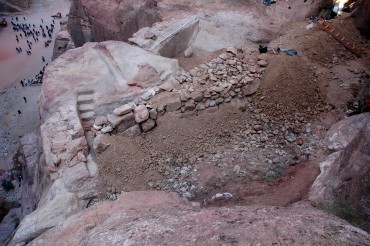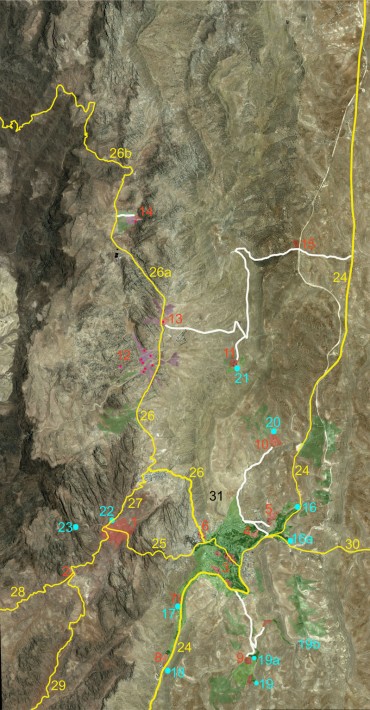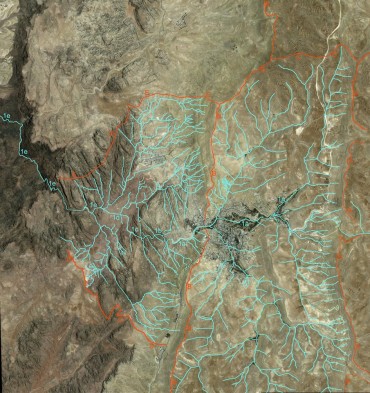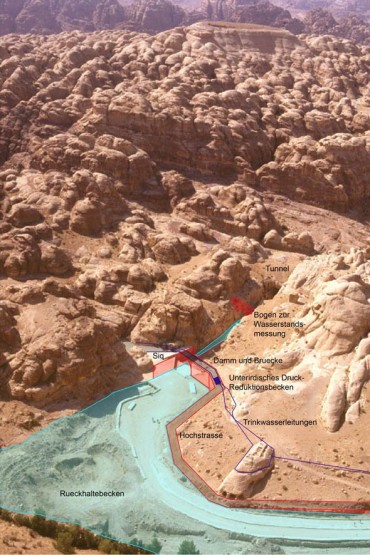
archaeological excavation in petra


satellite image of Petra and its surroundings with the settlements, the founts, the streets and the agricultural areas

satellite image showing the natural water ways

flood control system, 50-25 B.C. in the southeast of the entrance to the Siq

Ueli Bellwald explaining stucco wall to students of the ETH, march 2011
4.7.2012 – Issue 6 - Middle East 1 – Bellwald Ueli, Ivanišin Krunoslav, Baumgartner Marianne – Interviews
TRADITIONS
Interview with Ulrich Bellwald
There is a certain romantic aspect to the Middle East, very hard to avoid when we look at it from a European perspective: a mythical storybook place where anything can happen. How does the contemporary Middle East look from the inside, in terms of architecture?
After having lived for such a long period of time in a country of the Middle East I’m more and more astonished to realize that the most romantic approach to the oriental traditions is not the one from foreigners, but from locals. The really believe in all these myths and stories of “alf leilat wua leil”, they even take them as more realistic than the actual reality. Maybe that’s one of the main reasons why there is almost no attempt to bring these traditions into question, to discuss how to deal with these traditions with regard to the actual developments such as globalization. In terms of architecture this means, that in average there is no living and thriving contemporary design scene which works on developing a distinctly local or regional style, generating new ideas from traditional forms. Most what’s really somehow “new” is taken over from somewhere else, may it be a formal or a technical solution.
Yet it seems that within the broader region we can detect different areas which are specifically interesting from an architectural perspective: the area along the Mediterranean coast, where historical artifacts coincide with social tensions; the completely different Gulf area with its potential promise of the new city related to gas and petrol, and three big countries on the periphery of the Middle East: Turkey, Iran and Egypt, each a worlds in itself.
It is a widespread mistake of Westerners to take the Middle East as one entity, which it is absolutely not. There are tremendous differences between the cultures of the regions and the individual countries; furthermore it has to be taken into consideration that the actual political boundaries generally don’t have anything to do with the different cultural landscapes, as they were artificially drawn by the French and British after World War I. The countries of the Levant, mainly actual Lebanon, but also parts of Palestine, were over the centuries shaped by trade and commerce, hence they were also culturally at the crossroads, internalizing influences from many directions. Similar characteristics are distinguishing the great urban centers of actual Syria. Then there are the regions dominated up to some decades ago by a totally Bedouin lifestyle, with no settlements and therefore no urban or architectural heritage at all. The Gulf States were mainly part of this Bedouin region, what’s going on there is maybe what was going on in the Muslim world after the Umayyads got to power: They were buying all what they didn’t have themselves, all the know-how, material and labor-force required for achieving the goals they attempted to. The countries at the periphery are each one belonging to another cultural sphere with independent cultural structures, Turkey with at least partially close ties to the European past, Iran bringing in the great traditions from the far east and Egypt from North Africa, but mainly being a solid, self-sufficient rock. Hence the actual cultural situation, particularly in regard of architecture and urban design, is as heterogeneous as the various countries and their communities.
Is the current political and social transformation in the Arab world going to take an architectural form too?
Who knows about the future of the Arabic Spring? For the time being all these various political, economic and social movements have more virulent problems to solve than to discuss questions of architectural and cultural developments in general. I for myself am absolutely convinced that in the field of culture in general, the actual movements will basically lead to a step backwards, due to an increased influence of a traditional form of Islam on all aspects of life and social, commercial and hence cultural evolution. This means that there will be even less scientific and cultural curiosity, less trying out something new, but more going back to some nebulous traditions how a fake they may be.
Historically very interesting part of the Middle East is where the social and political tensions are most expressive today: Lebanon-Israel-Jordan-Syria-Iraq, the so-called Fertile Crescent. Is there a specific architectural potential related to that density of history and tension?
It definitely is, at least in some parts of the region, as may be shown by the urban and architectural efforts undertaken in Lebanon after the armistice had been concluded. Maybe such a development may once occur in the west Bank and the Gaza Strip, too, who knows. But for such efforts to take place it needs a well-established, self-conscious civil society, which doesn’t exist in many parts of the region. In Syria and in Iraq similar developments might be possible, because these countries have a millennia-old heritage of civil society, highly developed economy and a rich cultural and scientific tradition. Unfortunately most of the leading representatives of the intelligentsia of Syria and Iraq, almost the leaders in all fields of art (music, painting, sculpture, ceramics, writing), still have to make their living in the diaspora. For purely economic reasons a great number of academicians from all the countries of the region are forced to work outside their native country, for instance around 30’000 engineers from Jordan. There will be no real development in all fields of culture, if this brain drain due to the economic conditions may not be stopped.
Rapid development in the Gulf countries was interrupted by the economic crisis a couple of years ago. Do you see any realistic possibility of the new city being created there?
Most probably the economic crisis will only temporarily interrupt or slightly retard the implementation of the very ambitious urban projects set up by the Gulf States. But I really doubt whether what will emerge there may be classified as “the new city”. What’s being built there is somehow megalomaniacal, like other undertakings initiated by ambitious political leaders (to use a friendly word) the main objectives being to create the biggest, most costly, most precious buildings. All this achievement is only bought from outside, nothing is home-grown; it is imposed on no local roots. How may you call something ‘the new city”, if there is no and will never be what we call urban life? You may never create something new, something vital, by only ordering it and then looking at how it is done, without making your own hands dirty, without participating at it with at least part of your heart.
Could you point out some specific qualities related to the realization of an architectural project in the Middle East? Is there, to your opinion, something specifically Middle Eastern in contemporary architecture of the region, related to the specific context, to the specific material conditions, to the specific concepts of space and its use?
Unfortunately, how much I think about and how much I look in my record, I have to give you a negative answer. Due to the common unreflective intercourse with tradition and due to the almost total lack of cultural and scientific curiosity there is no attempt of developing forms and functions of the rich local heritage into actual creations. Depending on the social and educational system, nobody is asking himself what to do, nobody is looking for finding own, independent solution, but everybody is repeating what has been said by the elders in the family, by the Imam in the mosque or by the teacher in the classroom, everybody repeats what always has been done, without even thinking why. All the mosques being built every year in the region’s countries may easily illustrate what has been quoted: Almost all mosques being built look very alike, all with domed prayer halls following blindly the Ottoman model, as the Turks would still be ruling the area. No attempt in further developing the rich variety of forms and functions offered by the models of early Islam, from which still a respectable number is preserved.
You have been working in different fields within and around the common notion of architectural profession, from the development of architectural projects from the scratch to the reconstruction of archaeological facts. Do the two worlds; the frozen, ancient one and the dynamic, contemporary one exist in totally detached dimensions or there is a kind of vital relation between them? How important is the comprehension (and the actual reconstruction) of ancient structures for the contemporary reality of the Middle Eastern societies?
I only have to refer to my answer to the question here above. First I would deny that there is any vital or even sleeping involvement between ancient and contemporary art and architecture if it’s not fairy-tale kitsch production for decorative reasons in hotels etc. It is a fact to be observed that the rich cultural heritage, even going back for millennia, is not common property in the mind of most local people. For most of them cultural heritage only starts with the rise of Islam, what was before is of no value or even haram. Archaeological sites like Petra, Palmyra or Jerash are not estimated because they are part of the own cultural past, but because of the opportunities to generate revenue from tourism. The main goal of archaeological research is therefore to change people’s mind, to raise awareness for the importance of the own cultural heritage, to make people proud of the achievements of their ancestors and to highlight the level of cultural development the area once had and which contribution it once made to the development of the world. That’s where the importance of making ancient structures comprehensive to the contemporary societies is, to visualize the former cultural achievements, standards and levels in order to support people in getting self-conscious and gaining self-esteem.
Could you describe briefly your research into the Nabataean irrigation and water supply systems? Is there a relation between the production of knowledge about the ancient infrastructural makes and the contemporary, large scale infrastructural projects related to irrigation of the dessert, to the production of energy (Red Sea- Dead Sea project for instance)and alike?
We should not overestimate the ancient infrastructure systems by trying to use them as models for large scale contemporary solutions. The water supply, the flash-flood prevention and the water storage systems of the Nabataeans were, as sophisticated their construction was, designed for a restricted population living in a restricted area. Hence these ancient infrastructure systems may not at all be compared to such large scale projects as the Disi-Amman or the Red Sea-Dead-Sea water conveyor. But what we may learn from these ancient solutions is the way how we deal with the natural resources available.
Ulrich Bellwald is architect and archeologist and currently working on different archeological projects in Jordan for the Basel University, the Swiss-Liechtenstein Foundation for Archaeology Abroad and he is archaeological director of Petra National Trust’s project for the excavation and restoration of the Siq in Petra and its flanking hydraulic system.
Interview by Krunoslav Ivanisin and Marianne Baumgartner
Download article as PDF

